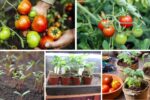Growing vegetables at home is not only a rewarding hobby but also a step toward healthier living and sustainability. Imagine stepping outside your kitchen to pick fresh tomatoes, crisp lettuce, or fragrant herbs—straight from your own garden. Whether you have a spacious backyard, a small balcony, or just a sunny windowsill, you can grow your own vegetables with the right approach. This guide will walk you through everything you need to know to start your home vegetable garden successfully.
1. Why Grow Vegetables at Home?

Homegrown vegetables offer a range of benefits that go beyond saving money on groceries:
- Freshness & Flavor – Vegetables harvested right before cooking are more flavorful and nutrient-rich than store-bought produce.
- Healthier Eating – Growing your own vegetables ensures you have access to fresh, chemical-free food.
- Sustainability – Reduces packaging waste and the carbon footprint of transporting food.
- Therapeutic Hobby – Gardening is proven to reduce stress and improve mental well-being.
- Educational for Kids – Teaching children how food grows builds a connection with nature.
Whether you want to enjoy organic food or just love the idea of getting your hands dirty, home vegetable gardening is for everyone.
2. Choosing the Right Location
The success of your vegetable garden starts with location.
- Sunlight – Most vegetables require at least 6–8 hours of direct sunlight daily. Leafy greens can tolerate some shade, but fruiting vegetables like tomatoes, peppers, and cucumbers thrive in full sun.
- Accessibility – Place your garden near your kitchen or main entrance so it’s easy to maintain and harvest.
- Water Access – Ensure the spot is close to a water source for convenient watering.
- Good Drainage – Avoid areas that collect standing water after rain, as excess moisture can cause root rot.
If you live in an apartment, choose sunny windowsills, balconies, or consider vertical planters.
3. Deciding Between Soil and Containers

You can grow vegetables either in the ground, raised beds, or containers.
- In-Ground Gardening – Best for those with ample outdoor space and good-quality soil.
- Raised Beds – Ideal for improving soil quality, drainage, and accessibility.
- Container Gardening – Perfect for small spaces, patios, and balconies. Almost any vegetable can be grown in a pot if the container is deep enough.
Tip: Use food-safe containers and ensure they have drainage holes to prevent waterlogging.
4. Selecting Vegetables for Beginners
If you’re new to gardening, start with easy-to-grow vegetables that don’t require much maintenance. Some great beginner options include:
- Tomatoes – Fast-growing, versatile, and highly productive.
- Lettuce & Spinach – Quick harvest cycle and grows well in containers.
- Radishes – Ready to harvest in just 3–4 weeks.
- Peppers – Thrives in warm climates and looks ornamental.
- Beans – High yield and enrich the soil with nitrogen.
- Herbs – Basil, mint, coriander, and parsley are perfect for small spaces.
Choose vegetables that suit your climate and season for better success.
5. Preparing the Soil or Potting Mix

Healthy soil is the foundation of a successful garden.
- For Ground or Raised Beds – Mix in compost, aged manure, and organic matter to improve fertility and structure.
- For Containers – Use a lightweight potting mix rather than garden soil to ensure proper aeration and drainage.
- pH Level – Most vegetables prefer a slightly acidic to neutral pH (6.0–7.0). You can test your soil with a simple pH kit.
Tip: Add organic fertilizers like bone meal or vermicompost to give plants a nutrient boost.
6. Planting Your Vegetables
Follow the seed packet instructions for planting depth and spacing. Crowded plants compete for light and nutrients, leading to poor yields.
- Direct Sowing – Plant seeds directly in the soil for vegetables like carrots, beans, and radishes.
- Transplanting – Start seeds indoors for tomatoes, peppers, and eggplants, then move them outside after seedlings are strong enough.
- Succession Planting – Stagger planting times to enjoy a continuous harvest throughout the season.
Tip: Mulch around your plants with straw, leaves, or wood chips to retain moisture and reduce weeds.
7. Watering the Right Way
Consistent watering is crucial for healthy growth.
- Frequency – Water deeply 2–3 times a week rather than lightly every day.
- Morning Watering – Water in the morning so plants can dry before night, reducing the risk of disease.
- Avoid Overwatering – Yellow leaves or soggy soil can be signs of too much water.
Pro Tip: Install a drip irrigation system or self-watering planters for low-maintenance watering.
8. Managing Pests and Diseases Naturally

Pests like aphids, caterpillars, and snails can damage your vegetables, but chemical pesticides are not the only solution.
- Companion Planting – Grow marigolds, basil, and garlic to deter pests naturally.
- Neem Oil Spray – Effective against most common garden pests without harming beneficial insects.
- Regular Inspection – Check leaves for signs of infestation and act early.
- Crop Rotation – Avoid planting the same vegetable in the same spot each year to reduce disease risks.
9. Harvesting Your Vegetables
Knowing when to harvest is key to enjoying the best flavor and texture.
- Leafy Greens – Pick outer leaves as needed, allowing the plant to keep producing.
- Root Vegetables – Check maturity by gently pulling one plant and adjusting timing if necessary.
- Fruiting Vegetables – Harvest when fruits are fully colored but still firm.
Tip: Harvest early in the morning when vegetables are crisp and well-hydrated.
10. Extending Your Growing Season
You can grow vegetables year-round with the right techniques.
- Cold Frames or Greenhouses – Protect plants from frost in winter.
- Indoor Gardening – Use grow lights to supplement sunlight.
- Successive Planting – Replace harvested crops with new seedlings.
11. Common Mistakes to Avoid

- Planting too many varieties at once – Start small and expand gradually.
- Ignoring soil health – Poor soil leads to weak plants and low yields.
- Overcrowding – Gives pests an advantage and reduces airflow.
- Forgetting to label plants – Avoid confusion, especially with seedlings.
- Over-fertilizing – Can burn roots and encourage excessive foliage growth instead of vegetables.
12. Final Thoughts
Starting a vegetable garden at home is an incredibly fulfilling journey. You don’t need a large yard or years of experience—just a bit of patience, planning, and care. By choosing the right vegetables, preparing healthy soil, and giving your plants the light, water, and nutrients they need, you can enjoy fresh, organic produce right from your own space.
Not only will you eat healthier, but you’ll also gain a deeper appreciation for nature’s cycles. So grab some seeds, roll up your sleeves, and watch your home garden come to life!







Leave A Comment